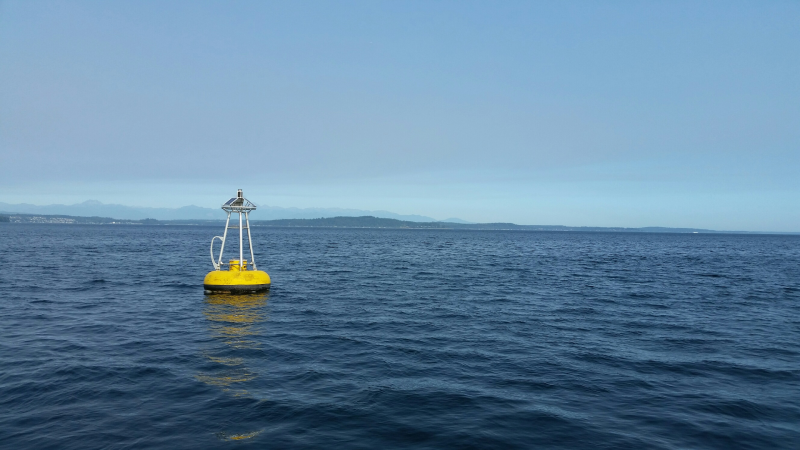Ocean Acidification
King County monitors ocean acidification conditions and trends in the county’s marine waters to help understand exposure risk to corrosive water as well as to inform management actions around mitigation. Corrosive water is a problem for shellfish and other animals with shells because their shells will either dissolve or not form properly.

We currently monitor indicators of ocean acidification at two locations: Point Williams and Quartermaster Harbor Yacht Club. These two locations represent deep Central Basin water and a shallow, protected embayment.
High-precision pH sensors (SeaFET V2) collect data every 15 minutes. These pH data are from a single depth near the surface at both locations. Other data, like temperature and salinity, are collected simultaneously as part of our Moorings Program. These additional data are necessary to fully characterize the carbonate system, which is a series of marine chemistry equations that determines how much shell-forming material (carbonate) is available at a given pH.
Once-a-month bottle samples are analyzed for two carbonate system parameters: total alkalinity (a measure of how resistant water is to further acidification) and dissolved inorganic carbon. We use these to calculate aragonite saturation state, which tells us how corrosive the water is. These samples are collected both at the surface and in deeper water.
We use the data we collect to understand day-to-day changes, seasonal changes, and long-term changes to carbon chemistry in Puget Sound. In shallow areas like Quartermaster Harbor, we see larger day-to-day changes in pH compared to deeper areas. It is important for us to understand these changes so we can better estimate exposure to corrosive water.
We expect water in Puget Sound to become more corrosive over timedue to climate change impacts. Our data can tell us the size of those impacts and how it is different between shallow and deep water.
More Information
The goals of this monitoring are to:
- Determine changes in ocean acidification parameters over days, seasons, and years.
- Compare measurements from different sensors to determine the most cost-effective way to accurately measure ocean acidification in more locations.
- Evaluate ocean acidification in the context of other observations from other King County marine programs.
- Make data available for regional scientists, policymakers, and the public.
| Parameter | Range | Resolution | Accuracy | Method |
|---|---|---|---|---|
| pH, initial | 6.5-9 | 0.0001 | N/A | SeaFET (w/ salinity correction) |
| pH, recalculated | 6.5-9 | 0.004 | ± 0.02 | SeaFET |
| Total Alkalinity | 2000–2500 µmol/kg | 0.1 µmol/kg | ± 2 µmol/kg | Dickson, A.G., C.L. Sabine, and J.R. Christian (Eds.) 2007. Guide to Best Practices for Ocean CO2 Measurements. PICES Special Publication 3: 191 pp. |
| Dissolved Inorganic Carbon | 1800–2300 µmol/kg | 0.1 µmol/kg | ± 2 µmol/kg | Dickson, A.G., C.L. Sabine, and J.R. Christian (Eds.) 2007. Guide to Best Practices for Ocean CO2 Measurements. PICES Special Publication 3: 191 pp. |
Download Data
Contact MarineWQ@kingcounty.gov for information about the data.
Documentation
Learn more about our program by reading the most recent relevant reports and presentations.
Contact us with any questions or access additional resources in the Science Section Library.

 Translate
Translate